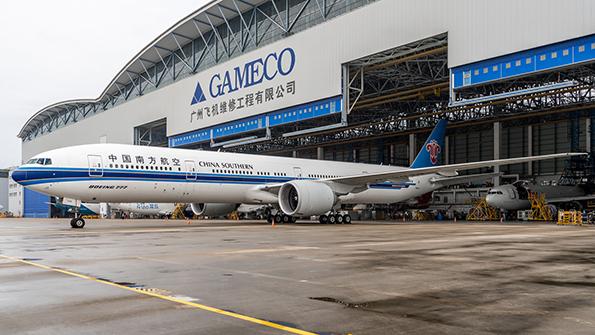Deferred Checks, Freighter Conversion Demand Boost 777 MRO Market

Some MROs expect a surge of heavy maintenance demand in the coming months as more 777s are reactivated from storage.
The Boeing 777 is the long-haul backbone for many global airlines, and as the OEM highlighted in its latest earnings call, the commercial market recovery is playing out better than expected.
Globally there were 116 airlines operating 1,551 777 passenger aircraft as of September and, of these, 684 are 777-200 types and 867 are 777-300 variants. Almost half of the fleet (771 aircraft, or 49.7%) are operated by major air carriers including Air France-KLM, American Airlines, British Airways, Cathay Pacific, Emirates, FedEx, Korean Air, Qatar Airways, Saudia and United Airlines. These 10 carriers have capabilities for airframe heavy maintenance work, but the remaining global fleet (beyond China) is dispersed among about 100 airlines, creating potential opportunities for independent MROs to tap into the market.
The freighter fleet includes two 777-300ERSFs powered by General Electric GE90-115Bs, and 231 777-200LRFs equipped with GE90-110Bs. In October, Boeing delivered a new 777 freighter to DHL, while also announcing an order for an additional five aircraft headed for Emirates.
As more 777s are reactivated from storage for revenue operations post-pandemic, several MROs are reporting a surge of heavy maintenance demand for the coming several months. HAECO, for instance, sees MRO demand that includes damage assessment and repair work, cabin restoration, modification and retrofit, as airlines start investing again in upgrading the passenger experience. The 777 freighters have also been flying robustly during the pandemic and the usual heavy maintenance demand remains high for them as well.
Almost half of the 777-200 variant aircraft are 20 years or older, and maintenance demand for the passenger fleet will likely shrink in the longer term. However, there might be some passenger-to-freighter (P2F) conversion demand, although industry experts have warned that feedstock pricing (the cost of acquiring passenger models for conversion) might be too high. The only highlight might come in the form of maintenance demand for freighter fleets.
As for the 867 777-300s, only 51 are not GE90 engine-equipped and the rest of the fleet is equipped with GE90-115Bs. The 777-300 variants are younger than the -200 variants and only 36 777-300s, or less than 5% of the fleet, are older than 20 years. None of these 36 aircraft are equipped with the GE90 engine.
The largest age cohort for active, in-service 777-200/-300s (including the 777-200ER/LR) aircraft is between 22-24 years old (83 aircraft), according to Aviation Week Network’s 2023 Commercial Fleet & MRO Forecast. For the 777-300ERs, the biggest age cohort currently is 7-9 years old (296 aircraft), and for purpose-built freighters, the 777-200F’s most prevalent age is 7-9 years old (138 aircraft).

Over the next decade, the 777-200ER model will lead in the number of 777 retirements, with 261 expected.
More than 60 777s are expected to be converted from passenger to freighter configurations over the next decade.
In terms of fleet maintenance, the outlook is far more positive for 777-300 variants, but also in the P2F market, where there is a huge existing fleet for feedstock candidates.
Current maintenance-cost trends for the 777 will depend on the post-pandemic utilization of the aircraft, suggests Benjamin Scheidel, CEO at HAECO Hong Kong. He indicates that some 777s were stored during the pandemic, so maintenance costs are expected to remain steady.
“Naturally, when the aircraft are utilized more post-pandemic, we may see higher maintenance costs, especially on the early models, driven by both cycle-based and hard time inspections [of parts that must be removed after a fixed time interval] in which more findings are expected when compared to the younger models,” Scheidel says. He adds that the same may also apply to the engines and other major components of the 777: “Some passenger airlines may want to include cabin refresh, which will drive cabin maintenance investment.”
Gameco CEO Norbert Marx says older 777s are more likely to have inspection findings and defects, resulting in increased maintenance labor-hours and longer downtime—especially in the fuselage section, where he expects more essential repairs in the near future. “Currently, one of the major maintenance issues for the 777 fleet is the structural inspection on the underwing longerons,” he says. “Once cracks are found, the aircraft must be repaired immediately, which requires special jacking methods.”
Total worldwide 777-family MRO demand is forecast to rise to $11.9 billion in 2023, with engine maintenance taking the largest share at 52%, followed by line maintenance and components at 15% and 14%, respectively. Modifications comprise 13% of the spending, while airframe heavy service checks account for 6% of the total.
Aviation Week data indicates annual MRO spending will increase to $13.7 billion in 2032, with engine maintenance rising to 56% of total spending. Regionally, the Middle East tops the in-service fleet counts of this type, with 305 aircraft now in that region. Top 777 operators at the end of 2023 include Emirates, with a projected fleet of 145, and Qatar Airways, with 88 anticipated. MRO demand from Middle Eastern 777 carriers alone is expected to reach $5.1 billion by 2032.




